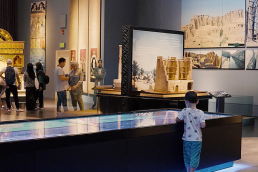This website uses cookies so that we can provide you with the best user experience possible. Cookie information is stored in your browser and performs functions such as recognising you when you return to our website and helping our team to understand which sections of the website you find most interesting and useful.
The Museum of Science and Technology in Islam (MOSTI)
ProjectThe Museum of Science and Technology in Islam (MOSTI) at The King Abdullah University of Science and Technology (KAUST)LocationSaudi ArabiaLighting Designerformula D_InstallerStage Audio Works, South AfricaSubmitted byChristie
The Museum of Science and Technology in Islam (MOSTI) celebrates many of the Islamic world’s stunning scientific achievements. Divided into seven zones, interactive technology leads visitors through the exhibits, offering an immersive look at various artefacts and relics in the museum’s collection.
The brief was to completely revamp and build on the foundation of the original technology present in the museum to create a guided experience with an updated, immersive feel, with interactivity as an essential component. This required a complete overhaul of the video and audio systems, as well as the networked elements.
Stage Audio Works (SAW) and formula D_ collaborated to devise a premium solution for MOSTI. The video element comprised most of the integration, including visual displays of all shapes and sizes. Thirteen Christie GS Series 1DLP laser projectors are installed throughout the museum, which are driven by a Christie Pandoras Box media server, a turnkey solution with a versatile render engine that facilitates projection onto any surface. This is used with some of the larger interactive exhibits, including an object theatre zone, where three projectors deliver a multi-screen immersive experience.
Another key attraction is a large 10-meter display closet, which was previously supported by touch foils situated behind the glass that were technically limiting and unsightly. This was replaced by a laser scanner that picks up multiple touchpoints across the cabinet. Additionally, almost 40 touchscreen panels were installed throughout the space to provide tactile interaction for formula D_’s bespoke set designs.
With the museum beginning to show signs of age, formula D_, a specialist in impactful visitor experiences, secured a tender for the technological curation and refurbishment of The Museum of Science and Technology in Islam (MOSTI), which had been last updated in 2009.
A complete overhaul of the audiovisual equipment was required to take advantage of the latest technologies and to deliver a modern storytelling experience. formula D_ contracted Stage Audio Works (SAW) to specify, supply, and integrate the equipment. RenderHeads Limited created the custom-made software used in the exhibits.
The main challenge was the age of the equipment that was present in the museum. “Everything was running on analog VGA, it had touch screens connected with RS232 cables, and the projectors had been in place for over a decade, so it seemed like the right time for a refresh,” said Nathan Ihlenfeldt, chief technology officer at SAW. “Our goal was to modernise all the technology and create a platform that could easily be updated and changed in line with the vision of the museum. Most of the content and exhibits remain the same, but all the technology was replaced from start to finish.”
The entire installation is now configured with HDBaseT using cat6 cable to allow for complete control of video. Other AV elements including speakers are all controlled via IP. The substantial network upgrades have simplified day-to-day operation and maintenance, as well as a backbone to allow for easier development should the museum wish to change its setup in the future.
The server room has also been streamlined, reduced from a total of 11 server racks to just four – which delivers lower power consumption. It runs on approximately 1/8th-1/10th of the power consumption of the previous system.
The system now provides a leaner and more energy-efficient solution designed to inspire the next generation, with strong network elements to enable future updates to the museum as and when necessary.
The Museum of Science and Technology in Islam (MOSTI) celebrates many of the Islamic world’s stunning scientific achievements. Divided into seven zones, interactive technology leads visitors through the exhibits, offering an immersive look at various artifacts and relics in the museum’s collection.
The brief was to completely revamp and build on the foundation of the original technology present in the museum to create a guided experience with an updated, immersive feel, with interactivity as an essential component. This required a complete overhaul of the video and audio systems, as well as the networked elements.
Stage Audio Works (SAW) and formula D_ collaborated to devise a premium solution for MOSTI. The video element comprised most of the integration, including visual displays of all shapes and sizes. Thirteen Christie GS Series 1DLP laser projectors are installed throughout the museum, which are driven by a Christie Pandoras Box media server, a turnkey solution with a versatile render engine that facilitates projection onto any surface. This is used with some of the larger interactive exhibits, including an object theatre zone, where three projectors deliver a multi-screen immersive experience.
Another key attraction is a large 10m display closet, which was previously supported by touch foils situated behind the glass that were technically limiting and unsightly. This was replaced by a laser scanner that picks up multiple touchpoints across the cabinet. Additionally, almost 40 touchscreen panels were installed throughout the space to provide tactile interaction for formula D_’s bespoke set designs.
The entire installation is now configured with HDBaseT using cat6 cable to allow for complete control of video. Other AV elements including speakers are all controlled via IP. The substantial network upgrades have simplified day-to-day operation and maintenance and provide a backbone to allow for easier development should the museum wish to change its setup in the future.
The server room has also been streamlined, reduced from a total of 11 server racks to just four – which delivers lower power consumption. It runs on approximately 1/8th-1/10th of the power consumption of the previous system.





